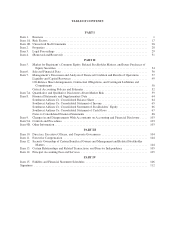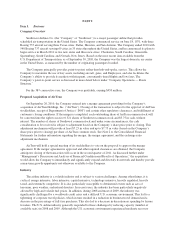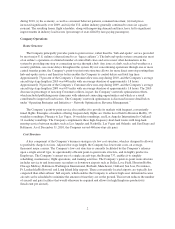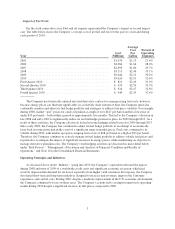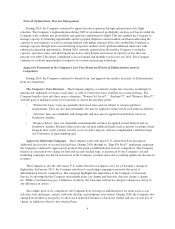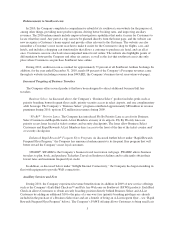Southwest Airlines 2010 Annual Report Download - page 16
Download and view the complete annual report
Please find page 16 of the 2010 Southwest Airlines annual report below. You can navigate through the pages in the report by either clicking on the pages listed below, or by using the keyword search tool below to find specific information within the annual report.and baggage liability requirements. The DOT is also charged with prohibiting discrimination by airlines and
focuses on ensuring that individuals with disabilities obtain nondiscriminatory access to the air transportation
system and that the public is not subjected to unlawful discrimination by airlines on the basis of race, religion,
national origin, or sex during the course of their air transportation.
Most recently, in 2010, a new DOT consumer protection rule (the “Passenger Protection Rule”) went into
effect to address, among other matters, tarmac delays and chronically delayed flights (i.e., flights that operate
at least 10 times a month and arrive more than 30 minutes late more than 50 percent of the time during that
month). Under the Passenger Protection Rule, U.S. passenger airlines are required to adopt contingency plans
that include the following: (i) the assurance that no domestic flight will remain on the airport tarmac for more
than three hours unless the pilot-in-command determines there is a safety-related or security-related
impediment to deplaning passengers or air traffic control advises the pilot-in-command that returning to the
gate or permitting passengers to disembark elsewhere would significantly disrupt airport operations; (ii) the
assurance that carriers will provide adequate food and potable drinking water no later than two hours after the
aircraft leaves the gate (in the case of departure) or touches down (in the case of arrival) if the aircraft remains
on the tarmac, unless the pilot-in-command determines that safety or security considerations preclude such
service; and (iii) the assurance of operable lavatories, as well as adequate medical attention, if needed. Air
carriers are required to publish their contingency plans on their websites.
The Passenger Protection Rule also subjects airlines to potential DOT enforcement action for unfair and
deceptive practices in the event of chronically delayed flights. Airlines are required to (i) display ontime
performance on their websites; (ii) adopt customer service plans, publish those plans on their website, and
audit their own compliance with their plans; (iii) designate an employee to monitor the performance of their
flights; and (iv) provide information to passengers on how to file complaints and respond in a timely and
substantive fashion to consumer complaints. Airlines that violate the Passenger Protection Rule are subject to
potential fines of up to $27,500 per passenger, the maximum allowed for violating any aviation consumer rule.
The DOT has expressed its intent to aggressively investigate alleged violations of the Passenger Protection
Rule. In June 2010, the DOT proposed a new rule that would expand the Passenger Protection Rule by, among
other things, (i) increasing the maximum denied boarding compensation airlines must pay to passengers
bumped from flights from $800 to $1,300; (ii) allowing passengers to make and cancel reservations within 24
hours without penalty; and (iii) strengthening the DOT’s enforcement policies concerning air transportation
price advertising practices.
Aviation Taxes. The statutory authority for the federal government to collect aviation taxes, which are
used, in part, to finance the nation’s airport and air traffic control systems, and the authority of the FAA to
expend those funds must be periodically reauthorized by the U.S. Congress. This authority was originally
scheduled to expire on September 30, 2007, but Congress has approved a series of extensions of this authority,
with the most recent extension set to expire on March 31, 2011. Congress is currently expected to adopt FAA
reauthorization legislation sometime in 2011. Other proposals that could be considered by Congress in
connection with the FAA reauthorization legislation include: (i) the imposition of new, or changes to, aviation-
specific taxes; (ii) an increase in the amount of airport passenger facility charges; and (iii) the adoption of new
unfunded mandates on commercial airlines such as new environmental, consumer, and labor standards, any of
which could have an impact on the Company’s operations.
The Wright Amendment. Section 29 of the International Air Transportation Competition Act of 1979, as
amended (commonly known as the “Wright Amendment”), prohibited the carriage of nonstop and through
passengers on commercial flights between Dallas Love Field and all states outside of Texas, with the exception
of the following states (the “Wright Amendment States”): Alabama, Arkansas, Kansas, Louisiana, Mississippi,
Missouri, New Mexico, and Oklahoma. Originally, the Wright Amendment permitted an airline to offer flights
between Dallas Love Field and the Wright Amendment States only to the extent the airline did not offer or
provide any through service or ticketing with another air carrier at Dallas Love Field and did not market
service to or from Dallas Love Field and any point outside of a Wright Amendment State. In other words, a
Customer could not purchase a single ticket between Dallas Love Field and any destination other than a
10


